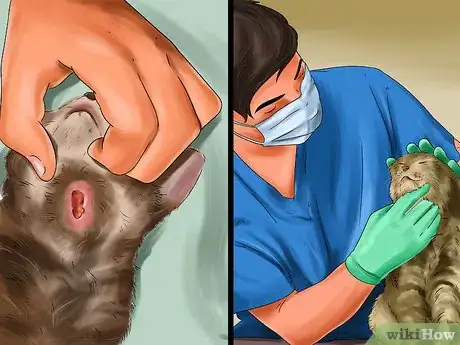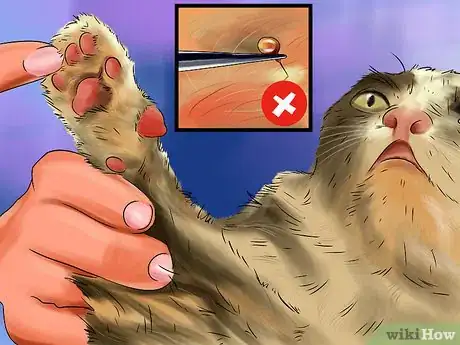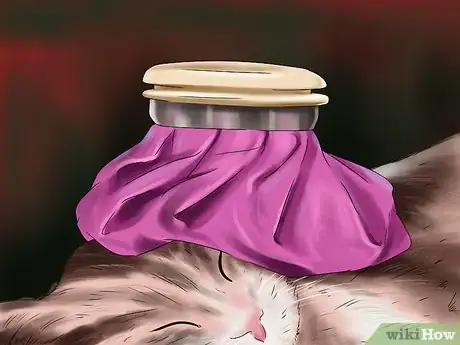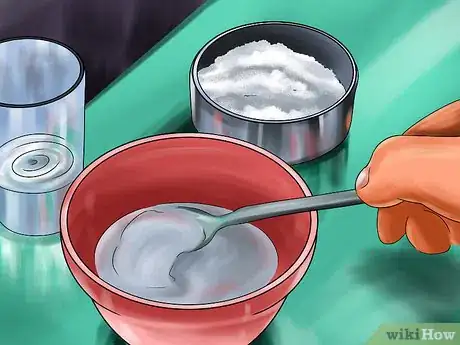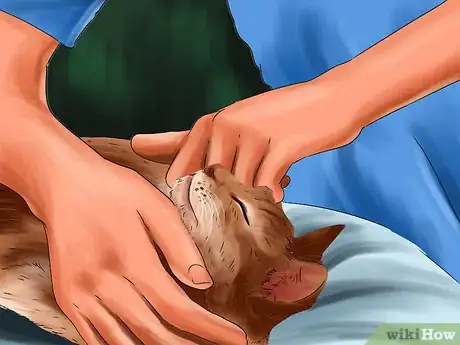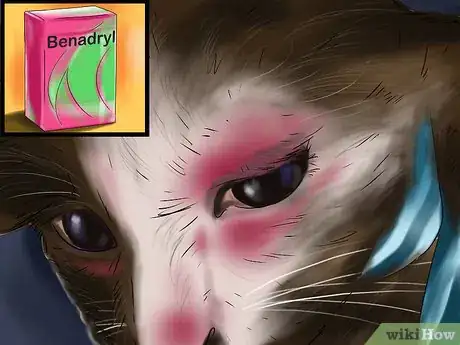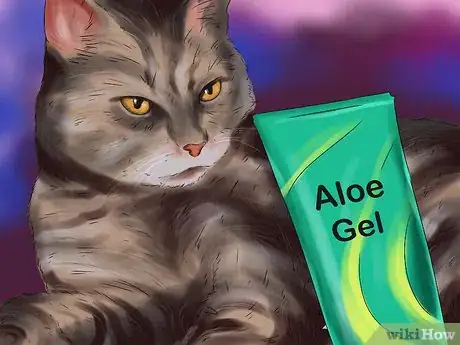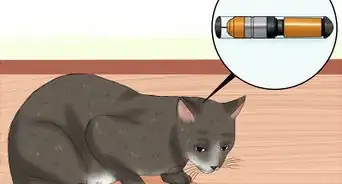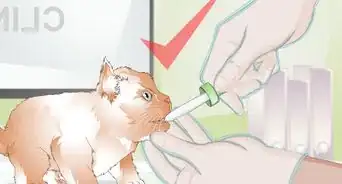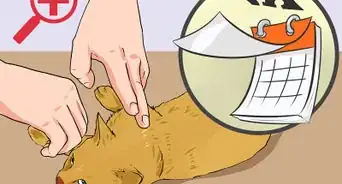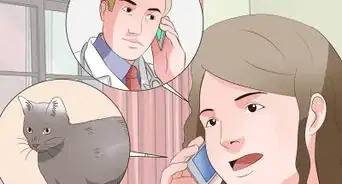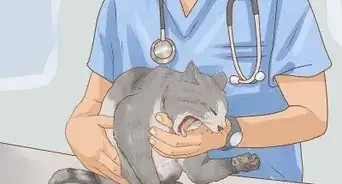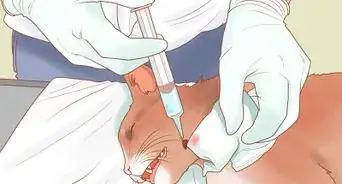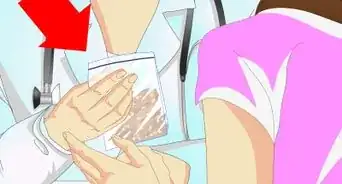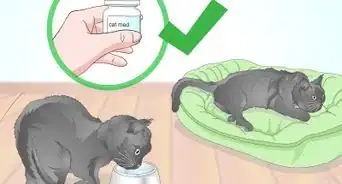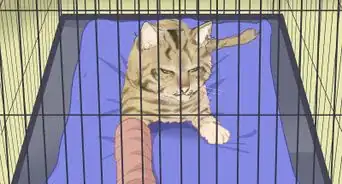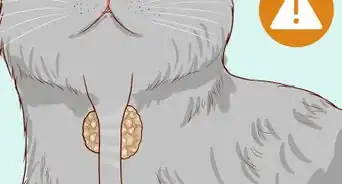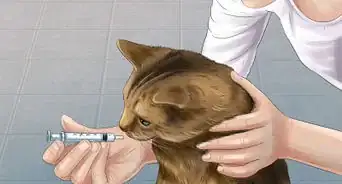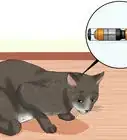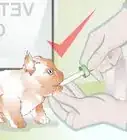This article was co-authored by Melissa Nelson, DVM, PhD and by wikiHow staff writer, Megaera Lorenz, PhD. Dr. Nelson is a Veterinarian who specializes in Companion and Large Animal Medicine in Minnesota, where she has over 18 years of experience as a veterinarian in a rural clinic. She received her Doctor of Veterinary Medicine from the University of Minnesota in 1998.
wikiHow marks an article as reader-approved once it receives enough positive feedback. This article received 11 testimonials and 86% of readers who voted found it helpful, earning it our reader-approved status.
This article has been viewed 267,561 times.
Cats love to hunt and play with insects. If your cat goes outside, there’s a good chance it will have an encounter with a bee at some point. Like humans, cats can be allergic to bees, and may have dangerous reactions to stings. In the event that your cat gets stung, you will need to quickly evaluate your cat’s condition, perform first aid, and perform appropriate aftercare.
Steps
Evaluating Your Cat’s Condition
-
1Check for signs of a severe reaction. If you know or suspect that your cat has been stung by a bee, you should quickly assess whether your cat is having a reaction that requires immediate medical attention. Take your cat to the vet or animal emergency room immediately if you see any of the following symptoms:[1]
- Rapid or labored breathing
- Facial swelling
- Pale gums or mucous membranes
- Vomiting (especially within the first 5-10 minutes after the sting) or diarrhea
- Weak or rapid heartbeat
- Collapse
-
2Try to determine what stung your cat. Bee stings are a little different from wasp or hornet stings, and you will need to take a slightly different approach to treatment depending on what kind of insect delivered the sting.[2] If you saw the insect that stung your cat but are not sure how to identify it, you may be able to narrow it down with a visual guide.
- Wasps do not usually leave their stingers behind when they sting, but bees generally do. If your cat was stung by a bee, you will need to find and remove the stinger.[3]
- Bee venom is acidic, while wasp venom is alkaline. It is better not to try to neutralize the sting with an alkaline substance (like baking soda) or an acid (like vinegar) unless you know for sure what stung your cat.[4]
Advertisement -
3Determine where your cat was stung. Look for signs of swelling, redness, or tenderness. If your cat has been stung in the mouth or throat, or if you suspect that your cat has been stung multiple times, take your cat to the vet immediately.[5]
Performing First Aid
-
1Remove the stinger, if it is still in place. If the cat was stung by a bee (rather than a wasp), the stinger is likely to be embedded in the cat’s skin. A bee stinger can continue to seep venom into the skin for several minutes after the sting is delivered. Try to remove it as soon as possible.[6]
- The stinger will look like a small black splinter.
- Gently scrape the stinger out with your fingernail, a butter knife, or the edge of a credit card.
- Don’t try to remove the stinger with tweezers or pinch it out with your fingers, or you might squeeze more venom into the wound.
-
2Apply a cold compress to the site of the sting. This can help soothe inflammation and reduce swelling. Wrap some ice or an ice pack in a washcloth and hold it on the sting for about five minutes. Take it off for five minutes, and then put it back for another five. Continue to do this for the first hour or so after the sting.[7]
-
3Apply a paste of baking soda and water to the site of the sting. Mix three parts baking soda (sodium bicarbonate) and one part water. Apply this mixture to the sting once every two hours until the swelling diminishes.[8]
- Do not treat the sting with baking soda unless you are certain that your cat was stung by a bee (rather than a wasp). For wasp stings, apply apple cider vinegar to the sting instead.
- If you're not sure what stung your cat, don't apply any poultice or liquid to the sting until you've taken your cat to the vet. Using the wrong treatment can cause more irritation.
- Take care not to get baking soda or vinegar in your cat’s eyes.
Performing Aftercare
-
1Keep an eye on your cat’s condition. If the swelling from the sting increases or spreads in the hours after the sting, contact your vet. Look out for signs of infection, such as redness, pus, or further swelling around the site of the sting over the next few days.[9]
-
2Ask your vet about giving your cat Benadryl. Benadryl (diphenhydramine) can help reduce inflammation, itching, and discomfort. Consult your vet about the appropriate dosage for your cat.[10]
- Do not give your cat a medication containing any ingredients other than Benadryl (diphenhydramine), as other types of medications intended for humans may be harmful or fatal to cats.
-
3Treat the sting with pure aloe gel. Be sure that the gel does not contain other ingredients, such as alcohol or lotion. Only use a very small amount. Take care not to get any aloe in your cat’s eyes.[11]
- Another option would be to apply a thin layer of triple antibiotic ointment to the site.
Expert Q&A
-
QuestionMy cat was stung by a wasp on his front paw and the paw is very swollen. I have applied apple cider vinegar, but it is still swelling. What should I do?
 Melissa Nelson, DVM, PhDDr. Nelson is a Veterinarian who specializes in Companion and Large Animal Medicine in Minnesota, where she has over 18 years of experience as a veterinarian in a rural clinic. She received her Doctor of Veterinary Medicine from the University of Minnesota in 1998.
Melissa Nelson, DVM, PhDDr. Nelson is a Veterinarian who specializes in Companion and Large Animal Medicine in Minnesota, where she has over 18 years of experience as a veterinarian in a rural clinic. She received her Doctor of Veterinary Medicine from the University of Minnesota in 1998.
Veterinarian In this case, you need to bring your cat to the veterinarian. He or she can give your cat an injection of a steroid to help immediately relieve the pain and discomfort.
In this case, you need to bring your cat to the veterinarian. He or she can give your cat an injection of a steroid to help immediately relieve the pain and discomfort. -
QuestionWhat will a small wild cat do if they get stung by a bee or a wasp?
 Melissa Nelson, DVM, PhDDr. Nelson is a Veterinarian who specializes in Companion and Large Animal Medicine in Minnesota, where she has over 18 years of experience as a veterinarian in a rural clinic. She received her Doctor of Veterinary Medicine from the University of Minnesota in 1998.
Melissa Nelson, DVM, PhDDr. Nelson is a Veterinarian who specializes in Companion and Large Animal Medicine in Minnesota, where she has over 18 years of experience as a veterinarian in a rural clinic. She received her Doctor of Veterinary Medicine from the University of Minnesota in 1998.
Veterinarian They will most likely paw at the area and hide until they are feeling better.
They will most likely paw at the area and hide until they are feeling better.
Warnings
- Do not apply essential oils to the sting. Essential oils may be harmful to cats, especially if ingested during regular grooming.⧼thumbs_response⧽
- Do not give your cat any painkillers intended for human use, such as aspirin, acetaminophen (Tylenol or Paracetamol) or ibuprofen (Motrin or Advil). These medications can be harmful or fatal to cats. Consult your vet if you are concerned that your cat is in pain.⧼thumbs_response⧽
References
- ↑ http://www.cat-world.com.au/Cat-Health-Collection/insect-bites-and-stings-in-cats.html
- ↑ http://www.purina.com.au/cats/health/emergencies/first-aid
- ↑ http://www.medicalnewstoday.com/articles/297999.php
- ↑ http://www.landcareresearch.co.nz/science/plants-animals-fungi/animals/invertebrates/invasive-invertebrates/wasps/first-aid
- ↑ http://www.cat-world.com.au/Cat-Health-Collection/insect-bites-and-stings-in-cats.html
- ↑ http://www.vetstreet.com/our-pet-experts/bee-stings-101-how-to-help-your-pet
- ↑ http://www.preventivevet.com/dogs/bee-and-wasp-stings-be-prepared
- ↑ http://www.preventivevet.com/dogs/bee-and-wasp-stings-be-prepared
- ↑ http://www.cat-world.com.au/Cat-Health-Collection/insect-bites-and-stings-in-cats.html
About This Article
To treat a bee sting on a cat, take it to the vet immediately if you notice severe reactions, such as vomiting or difficulty breathing. For milder reactions, use your fingernail to scrape the bee’s stinger out if it’s still in place. Then, wrap some ice in a washcloth, and apply it for 5 minutes at a time for the first hour after the sting, taking it off for 5 minutes in between applications. After that, mix 3 parts baking soda and 1 part water, and put the mixture on the sting once every 2 hours until the swelling goes down. For more tips from our Veterinary co-author, including how to care for the cat after you’ve administered first aid, read on!


